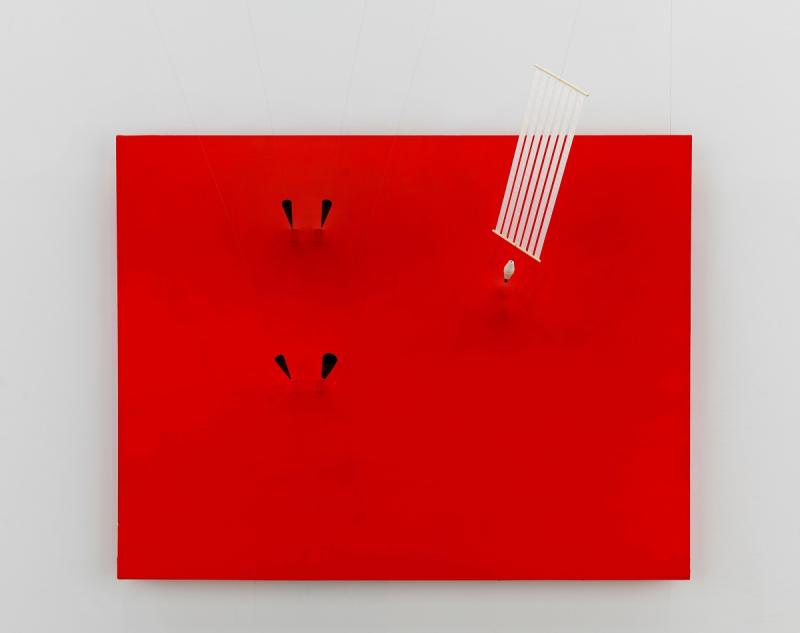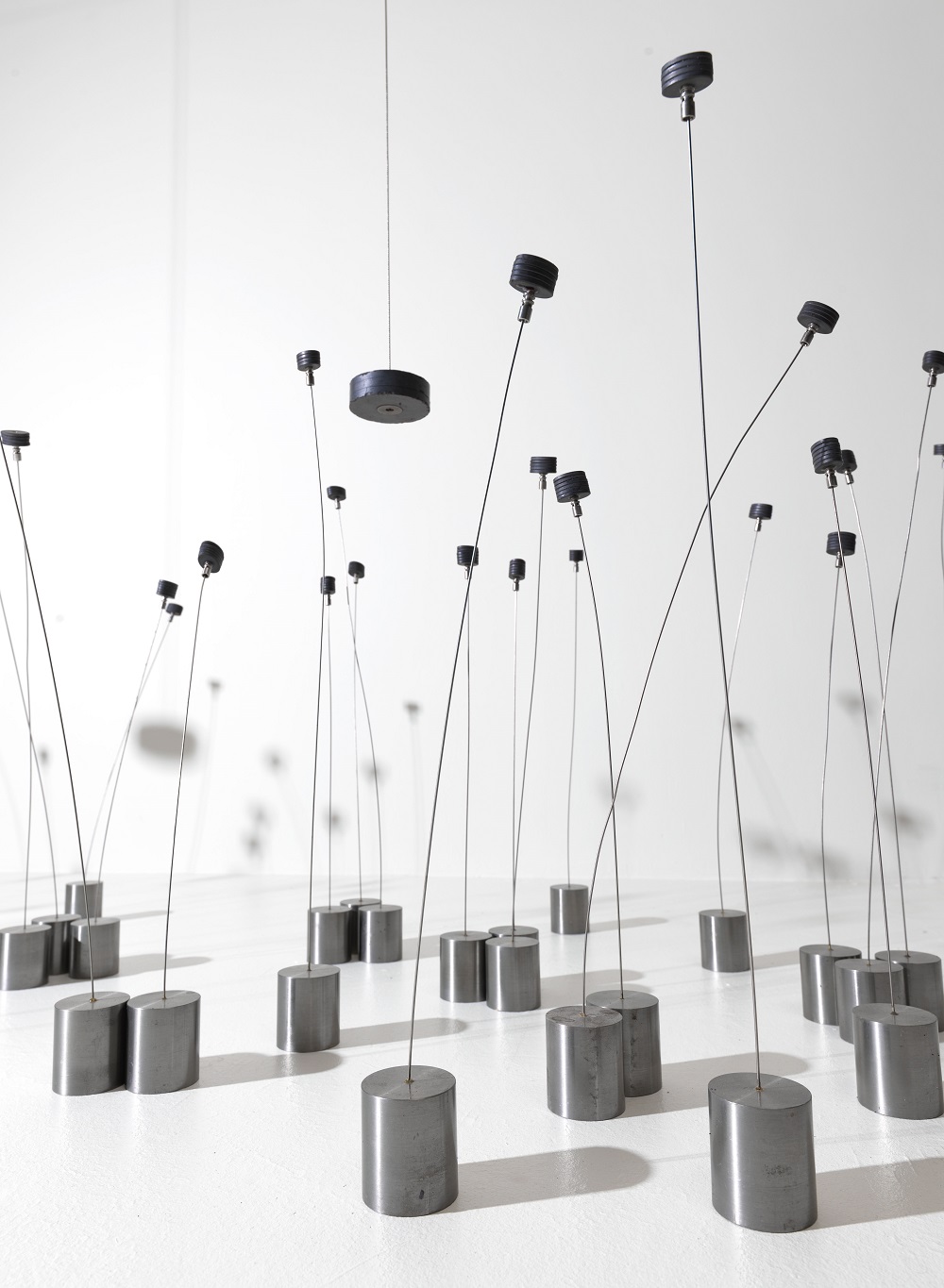Takis, Tate Modern review - science and art collide | reviews, news & interviews
Takis, Tate Modern review - science and art collide
Takis, Tate Modern review - science and art collide
Sculptor of magnetism, light and sound gets his first major UK retrospective

Half organic, half high-tech, a bank of magnet-flowers sways not in response to a breeze, but to a magnetic field. Their uncannily naturalistic movements are coupled with a form that is blatantly functional: an unseen, elemental force masquerades as nature at its most benignly pastoral (Pictured below right: Magnetic Fields, l969).
In his hands, painting too becomes a contested area: canvases bulge as magnets on either side of a painted surface hold a series of abstract objects aloft, as in Magnetic Wall 9 (Red), 1961 (Main picture). It’s a work that both defies and affirms the limitations of two dimensional representation, as objects floating in front of the canvas animate the picture plane, and declare it redundant.
 Born in Athens in 1925, Takis moved to Paris in 1954, joining the avant-garde circle based at the Beat Hotel, where he met artists and poets including William Burroughs and Allen Ginsberg. The radical possibilities of Takis’s new art were first revealed in 1960 when five months before the first man in space, Takis used electromagnetism to suspend the poet Sinclair Beiles in mid-air. From here, Beiles read his Magnetic Manifesto, in an action that, at the height of the space race, was as politically charged as it was artistic.
Born in Athens in 1925, Takis moved to Paris in 1954, joining the avant-garde circle based at the Beat Hotel, where he met artists and poets including William Burroughs and Allen Ginsberg. The radical possibilities of Takis’s new art were first revealed in 1960 when five months before the first man in space, Takis used electromagnetism to suspend the poet Sinclair Beiles in mid-air. From here, Beiles read his Magnetic Manifesto, in an action that, at the height of the space race, was as politically charged as it was artistic.
In the magnetic sculptures, basic principles are set adrift as the spaces between objects become loaded with significance, teeming with unseen energy as objects connect and communicate with each other. Throughout his career, Takis produced sculptures that look like aerials or antenna, and those that predate his experiments with magnetism in the 1950s look to ancient sculptural forms as a means of accessing some fundamental, primal force.
His sound sculptures are the most beguiling, their eery resonances echoing age-old cries into the void as humans have sought to reach beyond the confines of the known world. Pulses of electromagnetism pull rods against wires in a series of Musicals from the mid-1960s: stuttered, but pure sounds emerge. They sound as if they have been revealed, not made, by devices that are less musical instruments than scientific ones, transmitting the sounds of the cosmos itself. The language is all amusingly hippyish, but as today's sound artists continue to pick over roughly the same territory, the significance of Takis's project is less easily dated.
- Takis: Sculptor of Magnetism, Light and Sound at Tate Modern until 27 October 2019
- More visual arts reviews on theartsdesk
rating
Explore topics
Share this article
The future of Arts Journalism
You can stop theartsdesk.com closing!
We urgently need financing to survive. Our fundraising drive has thus far raised £49,000 but we need to reach £100,000 or we will be forced to close. Please contribute here: https://gofund.me/c3f6033d
And if you can forward this information to anyone who might assist, we’d be grateful.

Subscribe to theartsdesk.com
Thank you for continuing to read our work on theartsdesk.com. For unlimited access to every article in its entirety, including our archive of more than 15,000 pieces, we're asking for £5 per month or £40 per year. We feel it's a very good deal, and hope you do too.
To take a subscription now simply click here.
And if you're looking for that extra gift for a friend or family member, why not treat them to a theartsdesk.com gift subscription?
more Visual arts
 'We are bowled over!' Thank you for your messages of love and support
Much-appreciated words of commendation from readers and the cultural community
'We are bowled over!' Thank you for your messages of love and support
Much-appreciated words of commendation from readers and the cultural community
![SEX MONEY RACE RELIGION [2016] by Gilbert and George. Installation shot of Gilbert & George 21ST CENTURY PICTURES Hayward Gallery](https://theartsdesk.com/sites/default/files/styles/thumbnail/public/mastimages/Gilbert%20%26%20George_%2021ST%20CENTURY%20PICTURES.%20SEX%20MONEY%20RACE%20RELIGION%20%5B2016%5D.%20Photo_%20Mark%20Blower.%20Courtesy%20of%20the%20Gilbert%20%26%20George%20and%20the%20Hayward%20Gallery._0.jpg?itok=7tVsLyR-) Gilbert & George, 21st Century Pictures, Hayward Gallery review - brash, bright and not so beautiful
The couple's coloured photomontages shout louder than ever, causing sensory overload
Gilbert & George, 21st Century Pictures, Hayward Gallery review - brash, bright and not so beautiful
The couple's coloured photomontages shout louder than ever, causing sensory overload
 Lee Miller, Tate Britain review - an extraordinary career that remains an enigma
Fashion photographer, artist or war reporter; will the real Lee Miller please step forward?
Lee Miller, Tate Britain review - an extraordinary career that remains an enigma
Fashion photographer, artist or war reporter; will the real Lee Miller please step forward?
 Kerry James Marshall: The Histories, Royal Academy review - a triumphant celebration of blackness
Room after room of glorious paintings
Kerry James Marshall: The Histories, Royal Academy review - a triumphant celebration of blackness
Room after room of glorious paintings
 Folkestone Triennial 2025 - landscape, seascape, art lovers' escape
Locally rooted festival brings home many but not all global concerns
Folkestone Triennial 2025 - landscape, seascape, art lovers' escape
Locally rooted festival brings home many but not all global concerns
 Sir Brian Clarke (1953-2025) - a personal tribute
Remembering an artist with a gift for the transcendent
Sir Brian Clarke (1953-2025) - a personal tribute
Remembering an artist with a gift for the transcendent
 Emily Kam Kngwarray, Tate Modern review - glimpses of another world
Pictures that are an affirmation of belonging
Emily Kam Kngwarray, Tate Modern review - glimpses of another world
Pictures that are an affirmation of belonging
 Kiefer / Van Gogh, Royal Academy review - a pairing of opposites
Small scale intensity meets large scale melodrama
Kiefer / Van Gogh, Royal Academy review - a pairing of opposites
Small scale intensity meets large scale melodrama
 Jenny Saville: The Anatomy of Painting, National Portrait Gallery review - a protégé losing her way
A brilliant painter in search of a worthwhile subject
Jenny Saville: The Anatomy of Painting, National Portrait Gallery review - a protégé losing her way
A brilliant painter in search of a worthwhile subject
 Abstract Erotic, Courtauld Gallery review - sculpture that is sensuous, funny and subversive
Testing the boundaries of good taste, and winning
Abstract Erotic, Courtauld Gallery review - sculpture that is sensuous, funny and subversive
Testing the boundaries of good taste, and winning
 Edward Burra, Tate Britain review - watercolour made mainstream
Social satire with a nasty bite
Edward Burra, Tate Britain review - watercolour made mainstream
Social satire with a nasty bite
 Ithell Colquhoun, Tate Britain review - revelations of a weird and wonderful world
Emanations from the unconscious
Ithell Colquhoun, Tate Britain review - revelations of a weird and wonderful world
Emanations from the unconscious

Add comment